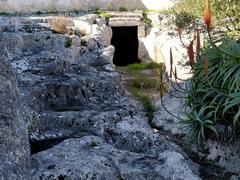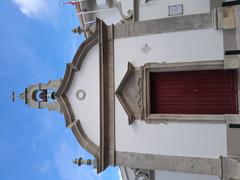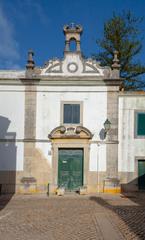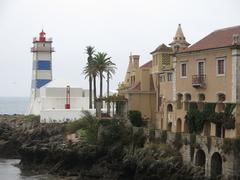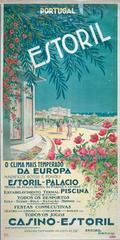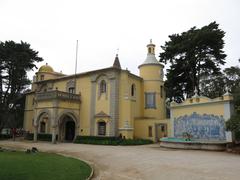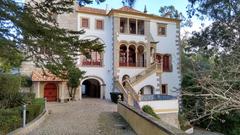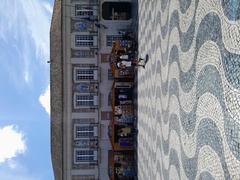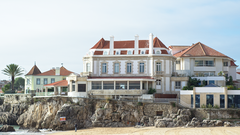Visiting the Fort of Cresmina, Estoril, Portugal: Tickets, Hours, and Tips
Date: 04/07/2025
Introduction
Nestled along the dramatic Atlantic coast near Cascais and Estoril, the Fort of Cresmina (Forte da Cresmina) stands as a testament to Portugal’s maritime defense heritage. Dating back to the 17th century, this historic fortress was constructed to safeguard Lisbon against piracy and invasion, and today, it draws visitors with its storied past, striking architecture, and breathtaking natural setting within the Sintra-Cascais Natural Park.
This comprehensive guide details the fort’s historical significance, architectural features, practical visiting information—including hours, ticketing, accessibility, and directions—and highlights nearby attractions. Whether you’re a history enthusiast or simply seeking spectacular coastal vistas, the Fort of Cresmina is an essential stop on any Cascais itinerary.
For current visitor information, consult official resources such as the Official Cascais Tourism Website, Sintra-Cascais Natural Park, and the architectural restoration project by Barbiniarquitectos.
Table of Contents
- Introduction
- Historical Background
- Location and Natural Setting
- Architectural Features
- Relationship to Other Regional Fortifications
- Visiting Information
- Visitor Experience and Nearby Attractions
- Tips for Your Visit
- Frequently Asked Questions (FAQ)
- Conclusion
- Useful Links
Historical Background
Origins and Strategic Purpose
The Fort of Cresmina was constructed in the 17th century during the Portuguese Restoration War, a time when Portugal was reasserting its independence from Spain. Its strategic location atop rocky cliffs above Cresmina Beach allowed for wide surveillance over the Atlantic approaches and the Tagus River estuary, forming part of a defensive network protecting Lisbon from seaborne threats (Guia da Cidade).
Architectural Development and Modifications
The fort was designed with Baroque military principles, featuring a compact polygonal bastion, thick stone walls, and a simple arched entrance. It was periodically modified and reinforced—most notably during the 18th and early 19th centuries—to adapt to evolving military needs. Facilities included barracks for a small garrison, a powder magazine, and artillery positions.
Decline and Modern Restoration
By the late 19th century, as the threat of invasion diminished, the fort fell into neglect and private ownership. In the 21st century, restoration efforts—particularly by Barbiniarquitectos—have stabilized and repurposed parts of the structure. Today, the fort serves as an events venue and, in some sections, a boutique hotel, blending historic ambiance with contemporary comfort (Barbiniarquitectos Project Details).
Location and Natural Setting
The Fort of Cresmina is perched above Praia da Cresmina, to the west of Cascais and near the famed Guincho Beach. Its isolated promontory provides dramatic views of the Atlantic Ocean and the rugged coastline. The fort sits within the Sintra-Cascais Natural Park, known for its biodiversity, rolling dunes, scenic trails, and rare endemic flora.
The Cresmina Dunes Interpretation Trail offers an immersive experience, with wooden walkways traversing the dunes and native vegetation. The fort’s location away from urban development enhances its tranquil, enigmatic atmosphere.
Architectural Features
- Plan and Structure: The fort’s core is a small, polygonal bastion with three main faces toward the sea, maximizing its defensive capabilities.
- Materials: Constructed primarily from local stone, the thick walls were designed to withstand both enemy artillery and the harsh Atlantic climate.
- Key Elements: Features include an arched main entrance, parapet, barracks, powder magazine, and later, a “gola wall” enclosing the rear for added defense.
- Current State: While some sections remain in ruin, restoration has preserved the fort’s distinctive outline and historic elements. The site’s adaptive reuse as an event space and boutique hotel demonstrates a modern approach to heritage conservation (Lisbon Beaches Guide).
Relationship to Other Regional Fortifications
The Fort of Cresmina was part of a coordinated chain of coastal defenses. Notable neighboring structures include:
- Forte de São Jorge de Oitavos: Now a military museum (Portugal Tips)
- Bateria da Galé and Bateria Alta: Fortifications built with similar defensive principles
- Fortaleza do Guincho: Reinforcing the coastal defense west of Cresmina
These forts collectively protected the approaches to Lisbon and supported each other with overlapping fields of fire.
Visiting Information
Hours and Tickets
- Exterior Grounds: Accessible year-round during daylight hours (generally 8:00 AM to sunset). No ticket required for exterior exploration.
- Hotel and Restaurant: The boutique hotel operates 24/7; the restaurant is open daily from 12:00 PM to 10:00 PM.
- Event Spaces and Guided Tours: Interior access is generally limited to hotel guests, restaurant patrons, or by special arrangement. Some guided tours may be available via local operators or by appointment (SintraCascaisSesimbra.com).
Accessibility
- Terrain: The fort is situated on cliffs with uneven ground and steep steps, which may pose challenges for those with mobility impairments. Some modernized sections of the hotel are accessible—contact the venue for details.
- Parking: Limited parking is available near Praia da Cresmina. Early arrival is recommended during peak season.
Directions
- By Car: From Lisbon, take the A5 highway or the scenic N247 to Cascais, then follow signs to Praia da Cresmina.
- By Public Transport: Take a train from Lisbon to Cascais, then continue by taxi or local bus to the fort area.
- Cycling/Walking: Coastal trails connect Cascais and Guincho, passing near the fort for those exploring on foot or by bike.
Visitor Experience and Nearby Attractions
- Cresmina Beach: A favorite for families and surfers, with both sheltered and open sections. Facilities include seasonal bars and parasol rentals.
- Guincho Beach: Renowned for windsurfing and natural beauty.
- Cresmina Dunes Interpretation Center: Offers educational exhibits on local ecology and guided walks (Portugal Tips).
- Cascais Town Center: Just a short drive away, featuring museums, restaurants, and the vibrant Estoril Casino.
- Nature Walks: Trails through the Sintra-Cascais Natural Park provide opportunities for birdwatching and photography.
Tips for Your Visit
- Best Time: Late spring through early autumn offers mild weather and ideal photography conditions, especially at sunrise or sunset.
- What to Bring: Comfortable shoes, sun protection, water, and a camera.
- Safety: Exercise caution near cliff edges and in the surf; lifeguards are present on the beach during summer.
- Dining: Enjoy fresh seafood at the fort’s restaurant or nearby beach venues. Reservations are recommended for dining and hotel stays.
- Conservation: Respect the protected natural environment by staying on marked paths and not disturbing local flora or fauna.
Frequently Asked Questions (FAQ)
Q: What are the Fort of Cresmina visiting hours?
A: The exterior is open to the public during daylight hours. Hotel and restaurant guests may access interior spaces; check with the venue for tour availability.
Q: Is there an entrance fee?
A: No ticket is required for exterior access. Hotel and restaurant services are paid, and guided tours (if available) may incur a fee.
Q: Are guided tours available?
A: Occasionally, by prior arrangement or through local tour operators.
Q: How do I get there from Lisbon?
A: Drive via the N247, or take a train to Cascais and continue by taxi or bus.
Q: Is the fort accessible for people with limited mobility?
A: Some areas are challenging due to uneven terrain and steps. The hotel offers some accessible features; contact them for specifics.
Q: Are dogs allowed?
A: Dogs are permitted on leashes in outdoor areas; check hotel policy for interior access.
Conclusion
The Fort of Cresmina is a unique intersection of history, architecture, and natural beauty on the Portuguese Riviera. Its resilient walls and commanding ocean views evoke centuries of maritime defense, while contemporary restoration has given the site renewed purpose as an events venue and boutique hotel. With easy access, free exterior entry, and proximity to beaches and nature trails, it’s a rewarding destination for history buffs, nature lovers, and travelers alike.
To make the most of your visit, check current hours and facilities, consider combining your trip with nearby attractions, and respect the natural environment that makes the fort’s location so remarkable.
Useful Links
- Official Cascais Tourism Website
- Fort of Cresmina on Wikipedia
- Barbiniarquitectos Project Details
- Sintra-Cascais Natural Park
- Lisbon Beaches Guide
- SintraCascaisSesimbra.com — Estoril Overview
- Trek Zone — Cascais Forts
- Guia da Cidade — Forte da Cresmina
- Portugal Tips — Things to Do in Cascais
Images and maps for further orientation and inspiration are available on the respective tourism websites.
